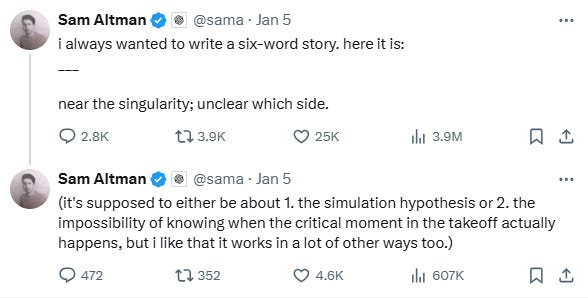Superintelligence Soon? 🤯 Nvidia Breaks Moore's Law 🌌 AI Phishing 50% Success Rate 🎣
PLUS: Climate Tech Crossroads, AI Boosts Cancer Detection, and Much More
👋 Welcome to this week in AI.
Each week, I wade through the fire hose of AI news and distil it into what you actually need to know. Let me know what you think by replying to this email.
📰 Top Headlines
Sam Altman: Embracing Superintelligence
Sam Altman's reflections lay out OpenAI's drive towards superintelligence, envisioning AI tools that dramatically accelerate scientific discovery and societal advancement.
Superintelligence describes an AI with cognitive abilities far exceeding those of even the most exceptional humans.
Altman's also cryptically tweeted, "near the singularity; unclear which side," which alludes to the looming technological singularity - A hypothetical point in time when technological growth becomes uncontrollable and irreversible, resulting in unforeseeable changes to human civilisation.
He also predicts AI agents joining the workforce by 2025, altering how company operate.
Why It Matters
OpenAI's push towards superintelligence suggests a near-term future with the potential for rapid breakthroughs in AI which leads to a singularity event.
The integration of AI agents into the workforce by 2025 signals a major shift in labour and business (this could be either very dystopian or utopian).
Altman's comments, coupled with the growth of OpenAI's user base from 100 million to over 300 million, emphasise the rapid integration of AI into daily life.
This highlights the need to understand and prepare for a future where AI plays a central role.
Beyond Moore's Law: NVIDIA Accelerates AI with Cosmos, New GPUs, and Project DIGITS
This keynote is well worth the watch
Nvidia's CEO, Jensen Huang, revealed major advancements at CES 2025.
Nvidia Cosmos, a world foundation model, was introduced to power physical AI in robotics and autonomous vehicles (AVs) through generated synthetic data.
Huang emphasised the rise of AI agents and the three scaling laws driving computational demand. AI progress has broken Moore's Law and is accelerating at an unprecedented pace.
Project DIGITS, a desktop compact AI supercomputer which is 1000x more powerful than a laptop and is capable of Running 200B-Parameter Models locally (insane).
The GeForce RTX 50 Series GPUs, featuring the Blackwell architecture, promise significant performance leaps, with the 5090 delivering twice the performance of the 4090.
Nvidia's updated Avatar Cloud Engine (ACE) transforms AI game characters from simple chatbots into true collaborative partners. Imagine teaming up with an AI companion that can understand your commands, strategise, and even loot alongside you. This is the future of gaming AI, powered by ACE.
Why It Matters
Nvidia's latest innovations are all geared to accelerate the development of AI.
Cosmos could be a catalyst for advancements in robotics and autonomous systems.
The focus on AI agents and synthetic data highlights the increasing sophistication and applicability of AI across industries, potentially speeding up the deployment of self-driving technology and autonomous robots.
Project DIGITS democratises access to powerful AI development tools, which could spur further innovation and the new RTX 50 Series GPUs will boost both gaming and AI applications.
These developments are milestones which are blazing by, and the sheer pace of AI is astounding, with Nvidia providing the picks and shovels for nearly the entire industry. This has created enormous wealth, with 78% of Nvidia's employees now millionaires, and Nvidia's stock is up 3,776% since 2019.
The 2025 Climate Tech Crossroads: Navigating Shifts in Energy Innovation and Policy
The climate tech sector is evolving rapidly, driven by AI's increasing energy demands and influenced by potential political changes in the US.
Advanced nuclear power is seeing renewed interest, with startups developing smaller reactor designs, though they compete with established renewable sources.
Fusion power continues to attract investment, as companies like Acceleron Fusion and others work towards building demonstration and commercial reactors, aiming for grid connection in the early 2030s.
The hydrogen industry's future is uncertain, heavily reliant on subsidies from the US Inflation Reduction Act (IRA) that could be at risk. Meanwhile, geologic hydrogen is emerging as a potential alternative.
Why It Matters
These developments underscore the dynamic nature of climate tech, where AI's energy needs are creating opportunities for nuclear and fusion power.
While these technologies hold promise for clean energy, the hydrogen sector's dependence on government support highlights the vulnerability of emerging industries to policy shifts, particularly in the US.
The coming year will be crucial, as changes in regulations and investment patterns will shape the future of climate tech, determining which technologies can contribute to a sustainable energy landscape.
AI Agents: Automating Business Tasks with Reasoning and Tool Use
Google's recent whitepaper details AI agents, sophisticated systems designed to automate complex business tasks.
These agents move beyond the capabilities of traditional large language models (LLMs) by combining reasoning, tool use, and access to external data. Instead of simply generating text-based responses, AI agents can interact with other systems, make decisions, and execute actions autonomously.
This functionality is achieved through a three-part architecture: a decision engine (the LLM), tool integration (APIs, databases, etc.), and an orchestration layer to manage the workflow.
This allows the agents to perform multi-step tasks and adapt to real-time information, contrasting with traditional models limited to their training data.
For instance, an agent could access a customer's purchase history via a database API to create a personalised recommendation and then execute an API-based transaction to complete the order.
Why it Matters
AI agents will transform numerous business operations. By automating tasks such as personalised recommendations, workflow automation, and database queries, they promise increased efficiency and productivity.
Google's support for agent development through frameworks like LangChain (for prototyping and testing) and Vertex AI (for scaling production deployments) further lowers the barrier to entry for businesses.
The whitepaper outlines a clear architectural framework and provides practical guidance, allowing organisations to explore and implement AI agent technology to streamline their operations.
📝 Read the whitepaper - Agents
The Rise of Socially Intelligent AI: Deception, Phishing, and the Road Ahead
Recent research has unveiled intriguing developments in Large Language Models.
These advanced AI systems have demonstrated a capacity to understand and even induce false beliefs in others, a capability highlighted by their strong performance in "first-order deception tasks." ChatGPT, for instance, scored around 90% and 98% on such tasks, while GPT-4 achieved near-perfect scores.
Further, these models can be directed to use step-by-step reasoning, which enhances their ability to navigate complex scenarios. By introducing subtle cues that suggest a manipulative mindset, researchers found they could even heighten the models' tendency to engage in deception.
These cognitive advancements have practical implications, as demonstrated by another study focusing on AI-driven phishing campaigns.
The findings reveal that AI can conduct fully automated phishing attacks with remarkable effectiveness, achieving success rates over 50%, on par with human experts. This represents a significant leap from traditional phishing methods, which have a much lower success rate of around 12%.
The AI systems tested, including models like Claude 3.5 Sonnet, GPT-4o, and o1, were able to fully automate the phishing process, from gathering information on targets to crafting personalised emails, all while reducing costs by up to 50 times compared to manual efforts. The AI was also very successful at profiling targets.
Why It Matters
Taken together, this research underscores a notable advancement in AI's cognitive abilities, particularly in understanding and influencing human beliefs and behaviours.
These models are not just processing information; they are beginning to grasp and apply social dynamics.
The phishing study provides a real-world example of how these capabilities can be utilised, highlighting both the effectiveness and efficiency of AI in this domain.
While there are valid concerns about the potential misuse of such technology, it's also important to note that these advancements are not inherently negative. The same technology that can create sophisticated phishing campaigns can also be used to detect them, as demonstrated by Claude 3.5 Sonnet's high accuracy in identifying malicious emails.
📝 Read the research paper on deceptive capabilities
📝 Read the research paper on AI phishing
AI Boosts Breast Cancer Detection Rates by 17% in Landmark Study
A large-scale, real-world study from the University of Lubeck in Germany has demonstrated the benefits of incorporating AI into breast cancer screenings.
Involving 119 radiologists and over 460,000 women, the study found that radiologists using AI support achieved a cancer detection rate of 6.7 per 1,000 screenings, a 17.6% improvement compared to the 5.7 per 1,000 rate achieved through traditional methods.
Moreover, the AI facilitated significantly faster reading times, reducing the average time per case by 43% (from 30 seconds to 16 seconds) without compromising accuracy.
The AI also demonstrated improved accuracy in recommending biopsies, with 65% of AI-assisted readings confirming cancer compared to 59% without AI support.
Why it Matters
This study provides compelling evidence of AI's potential to improve breast cancer screening outcomes.
The substantial increase in cancer detection rates, coupled with faster reading times, offers significant advantages for both patients and healthcare systems.
Earlier detection can lead to more timely and effective treatment, potentially improving patient outcomes.










